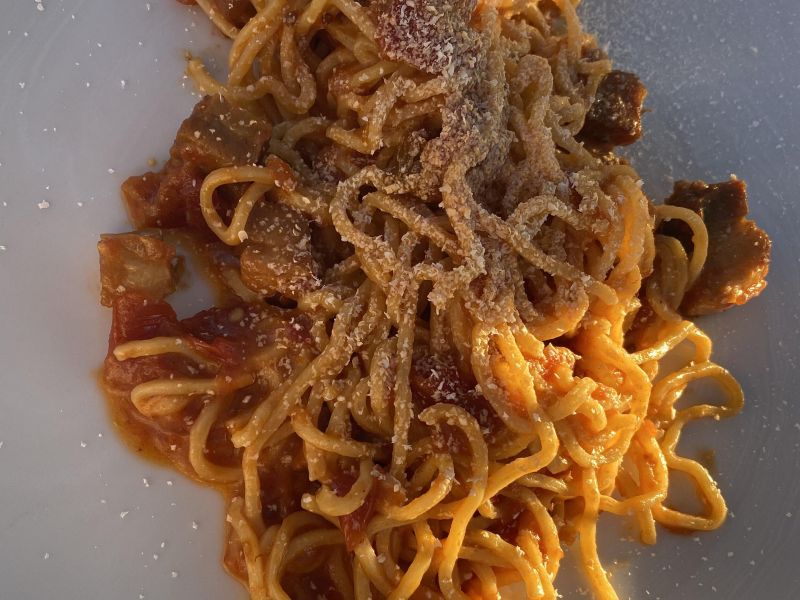There are few dishes that capture the spirit of central Italy quite like Pasta Amatriciana. Born in the rustic hills of Amatrice and perfected in the trattorias of Rome, this pasta blends simple ingredients—guanciale, Pecorino Romano, and tomatoes—into a rich, flavorful dish that’s beloved by locals and travelers alike. It’s fast, fiery, and full of character. Think of it as Rome on a plate: bold, no-nonsense, but deeply comforting.
At its core, Pasta Amatriciana is proof that minimalism in Italian cooking doesn’t mean sacrificing flavor. It’s made with ingredients that were easy to carry for shepherds—salted pork, hard cheese, and pasta—and elevated by the arrival of tomatoes in Italian cuisine. This is one of the four classic Roman pastas (carbonara, cacio e pepe, gricia, and amatriciana), and it’s often the gateway for food lovers discovering the joys of Roman culinary tradition.
History of the Recipe
Pasta Amatriciana has a fascinating and emotional story. Its predecessor, pasta alla gricia, was made without tomatoes and dates back centuries, long before tomatoes arrived from the New World. When tomatoes were introduced to Italian cuisine in the 1700s, cooks in Amatrice began adding them to their beloved pasta, and amatriciana was born. The dish gained further fame in Rome, where it became a symbol of Lazio’s rustic yet refined food culture.
The dish took on even greater cultural significance after the 2016 earthquake that devastated Amatrice. Chefs around the world rallied, putting Amatriciana on their menus and donating proceeds to help rebuild the town. That act of culinary solidarity made this dish not just iconic—but symbolic
Did you know?
Pasta all’Amatriciana is more than a dish—it’s a rite of passage for anyone cooking or eating in Rome. You’ll find it on nearly every menu in the Eternal City. Beloved Roman institutions like Roscioli, Trattoria Da Teo, and Da Enzo al 29 serve this pasta with slight variations, but always with deep respect for the original ingredients.
Celebrity chefs including Massimo Bottura, Gabriele Bonci, and Lidia Bastianich have each paid tribute to it. And let’s not forget Stanley Tucci, whose show Searching for Italy featured Amatriciana while exploring Roman food culture—he described it as “the soul of Rome.” Whether you’re watching a cooking show or reading an Italian food memoir, chances are this fiery red pasta makes an appearance.
This is your guide to making a restaurant-quality Amatriciana at home—no plane ticket needed.

Pasta Amatriciana
Equipment
- Large pot for boiling pasta
- Skillet or sauté pan
- Wooden spoon
- Cheese grater
- Strainer
Ingredients
- 12 oz Bucatini pasta Rigatoni can be used
- 6 oz Guanciale, diced can substitute pancetta if necessary, but less authentic
- 1 tbsp Olive oil
- 1/2 tsp Crushed red pepper flakes
- 1 can San Marzano tomatoes DOP, crushed or whole and hand-crushed 14oz or so
- 1/2 cup Pecorino Romano cheese finely grated
- Salt & pepper to taste
Instructions
- Bring a large pot of salted water to a boil and cook the pasta until al dente. Reserve 1/2 cup of pasta water before draining.
- In a large skillet, heat olive oil over medium heat. Add guanciale and cook until golden and crisp, about 5–7 minutes. Don’t rush this step—the rendered fat is key to the sauce’s flavor.
- If using, add red pepper flakes and stir for 30 seconds.
- Add the crushed tomatoes and a pinch of salt. Simmer gently for about 10–12 minutes, allowing the sauce to reduce and flavors to meld.
- Add drained pasta to the sauce, tossing well to coat. Add a bit of reserved pasta water if needed to loosen the sauce.
- Remove from heat and mix in grated Pecorino Romano. Season with black pepper.
- Serve hot, topped with extra cheese if desired.
